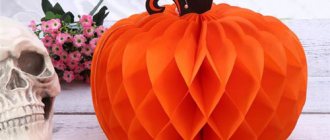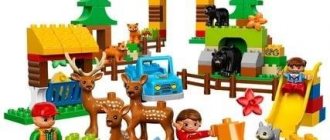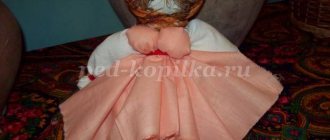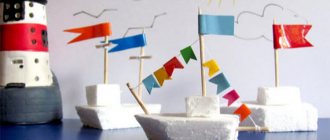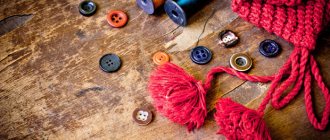Summary of GCD on design using origami technique in the senior group “Lisichka”
Lyudmila Alekseevna Muratova
Summary of GCD on design using origami technique in the senior group “Lisichka”
Abstract of GCD for design in the senior group
"
Fox " Origami
Purpose: To teach children how to design a fox out of paper .
Teach children to construct a fox out of paper using the origami technique . Strengthen the ability to bend a sheet of paper and glue small parts.
Develop fine motor skills and encourage creativity.
Cultivate a desire to design paper crafts and the ability to finish something started.
Reading fiction fairy tale “ The Fox , the Little Sister and the Gray Wolf”
, asking riddles about animals, looking at pictures
“Fox with cubs”
.
Vocabulary work: Red.
Methodological techniques. Conversation, explanation of questions to children.
Orange paper, blanks for eyes and nose, scissors, glue.
Progress of the lesson.
Educator: - Guys, listen carefully to this poem.
The streams rang, the rooks flew in,
The bee brought the first honey to her hive.
Who can say, who knows when this happens?
What time of year are they talking about? Why do you think so? (Children's answers)
.
Indeed, spring has come. Every day the sun gets warmer and hotter. And under its rays the beauty of all life on earth is revealed: blades of grass, leaves, bushes, flowers.
Today we will make our own miracle flowers
, we will look and admire them.
But first, let's remember and talk about living nature. What does this mean? Name it. (Plants, wild and domestic animals)
.
Why do you think that plants (flowers)
alive
(They grow, eat, breathe, live, reproduce, die)
.
Yes, flowers surround
and decorate our lives. That's why we all love and admire them all. Did you know that plants and flowers bring great benefits to humans? They absorb bad air, calm the nervous system, and give us their beauty, so flowers and plants must be protected.
Tell me what spring flowers do you know? (Children call them)
.
Now tell me what all plants have in common? What parts? (Flower, stem, leaves, seeds, roots)
.
Showing and examining a sample: - Guys, look at our unusual flower. Pay attention to how its petals and leaves are folded. Compare it with other flowering plants.
Now let's stand up and imagine that we are flowers.
Physical exercise: Flowers rose in pots on the window.
/Children squat in a circle, then slowly rise/.
They reached out to the sun, they smiled at the sun. / Stretch on your toes, raising your arms up /.
The leaves of the flowers are turned towards the sun. /Spread your arms to the sides, palms up/.
The buds will unfurl and drown in the sun. / They join their hands above their heads and slowly sway/.
Did you guys like being flowers? How did you feel now? Let's stretch our fingers.
Finger gymnastics:
We cut and cut paper.
We are tearing the paper, tearing it.
We glue paper, glue it.
We crumple the paper, crumple it.
Practical part of the work: they begin to work at tables, to calm music and under the guidance of a teacher.
1 "Flower"
: First fold one colored square diagonally, then into a basic
“kite”
. He repeats this two more times.
2 "Leaves"
: First, one green square is folded diagonally, then unfolded. The right and left corners of the square overlap each other. The second square is also folded.
3 The details of the future plant are glued one by one onto the cardboard base. First a stem, then three petals. After one or two leaves.
Summing up the lesson
: -Let's see what we got.
Admire our miracle flowers
. How beautiful they are!/Exhibition of finished works/.
In conclusion, let's play the game "Guess the Flower"
. I’ll tell you a riddle, and you tell me what flower it’s talking about.
1 On a blade of grass, like pieces of ice, are snow-white flowers.
And the flowers hide them from view along the path. (Lily of the valley)
.
2 A wonderful flower, like a bright light.
Lush, important, like a gentleman, velvety (Tulip)
.
3 Drops of sun appeared early in the clearing.
He dressed up in a yellow sundress (Dandelion)
.
4 This blue flower reminds you and me of the clear, clear sky and the radiant sun. (Forget-me-not)
.
5 He is a flower prince-poet wearing a yellow hat.
An encore sonnet about spring will be read to us (Narcissus)
.
Our spring flowers are drops of beauty! Let them grow, bloom, let them bring us joy! Take care of them!
Publications on the topic:
“Flowers for mom, flowers for mom I press to my heart. Flowers for mom, flowers for mom, I carry them with trepidation today!” (Yu. Verizhnikov).
Summary of an individual speech therapy lesson on sound automation [h]. Topic: “On the Miracle Island...” Synopsis of an individual speech therapy lesson on sound automation [h]. Topic: “On the Miracle Island...” Goal: automation of the sound [h] in syllables.
Abstract of GCD in the form of a game situation, non-traditional drawing technique in the older group. Topic “Flowers” Summary of GCD in the form of a game situation. Artistic and aesthetic development of non-traditional drawing techniques in the older group. Theme "Flowers".
Summary of GCD in the form of a game situation. Non-traditional drawing technique in the senior group. Theme “Flowers” Theme “Flowers” Objectives: Encourage children to convey in the drawing the shape of flowers, location, color scheme. Develop children's creative imagination.
Summary of an origami lesson in the senior group: “Box with tulips” Goal: Continue to teach children how to fold paper figures on their own.
MUNICIPAL BUDGETARY EDUCATIONAL INSTITUTION OF ADDITIONAL EDUCATION
"CREATIVITY CENTER OF ZAVODSKY DISTRICT"
CITY OF KEMEROVO
Lesson topic
: Paper plastic “Flowers using origami technique.”
Educational activities
: DPI
Children's age:
7-12 years
The educational role of origami
Origami helps to spend leisure time and solve many educational problems .
By folding paper figures, you can develop in a child confidence in his abilities, creativity, love of art, and imagination. By improving finger movements and developing fine motor skills with the help of origami, you can influence intellectual and speech development. Exercises have a beneficial effect on memory formation. In the process, children remember the actions they perform and reproduce them in the future.
The educational role of origami is to develop independence and the formation of aesthetic taste.
The process of folding figures brings children pleasure . With the help of step-by-step actions, the child receives a car, plane, ship or frog that comes to life in his hands. Therefore, such activities are interesting to them.
Does your child do origami?
Not really
Paper is a universal constructor . It allows you to get a finished toy from an ordinary sheet. Educators use these activities in kindergartens and recommend repeating them at home.
Making crafts helps:
- develop perseverance;
- create positive feelings (after all, a toy can become a gift for loved ones);
- discipline;
- show creativity;
- favor theatrical, constructive and visual talents.
In kindergarten, origami helps prepare children for school. Classes contribute to the formation of important skills:
- the ability to listen carefully;
- take a responsible approach to the task and its implementation;
- reorient consciousness from the outcome of the task to the search for its completion;
- self-control;
- awareness of one's cognitive processes.
The main form of training is recommended to be carried out in small subgroups . Making toys requires precise finger work. The teacher needs to provide individual assistance to each child.
The main tasks of origami in the middle group:
- teach your child to design and be able to create three-dimensional crafts using this technique;
- develop finger motor skills;
- show creativity and artistic taste;
- instill patience and love of work.
When the child has formed and consolidated an idea of how to work with paper, his imagination will begin to manifest itself, and he will be able to follow the teacher’s verbal instructions. Making origami also helps with mathematical preparation. In the process of paper creativity, children study geometric shapes, including polygons, focusing on the sheet. Putting together crafts in a group helps develop communication skills and foster a desire to interact with peers and adults.
Department: arts and crafts
1. Plan………………………………………………………………………………2
2. Progress of the lesson…………………………………………………………… …………………3
3. References……………………………………………………8
4. Appendix………………………………………………………9
- Location:
classroom
Time mode
– 2 academic hours
Student age:
from 7 to 12 years.
Teaching methods
– verbal, visual, practical, explanatory and illustrative.
Type of lesson –
combined
Form of organization of student activities
- collective, individual.
Methodology and options for constructing classes
Before you start making origami with your children, you need to master the basic rules of folding and working techniques, basic forms.
The implementation of the origami making technique for the senior group consists of the following points:
- carrying out system work;
- folding figures from simple to complex;
- searching for an individual approach to everyone;
- providing independent choice;
- organization of interaction;
- creation of thematic cycles.
When implementing the methodology for conducting origami classes for older preschoolers, you can use the following types of work:
- individual;
- group;
- with parents (there may be consultations, group meetings);
- creative activities together with children and their parents (for example, a circle).
Editorial Voice
Irakli
Lord of Paper Sheets
Ask a Question
Training with children, structured according to the methodology, should have three stages : initial, main, final.
Elementary
Children need to be told that the birthplace of origami is Japan . Here you can create a thematic album, watch a cartoon, play a game. The teacher can tell the children why paper is needed, what it is made from and what crafts can be made from it.
The following classes are conducted:
- The production of basic forms and simple crafts begins. It could be a book, candy or ice cream. The site for the exhibition is being prepared.
- A parent meeting is held. Parents are encouraged to collaborate with their children. A consultation is being held on the topic “Why activities with paper are so important for children”, “What can be made from paper”.
- Methodological literature is selected. A long-term plan for classes in the circle is developed, and didactic material with different levels of complexity is selected.
- A designated corner is created in the group. It will display crafts of different levels that the children were able to make. Additionally, a file cabinet with finger exercises is installed in the corner.
Basic
At this stage of training, the teacher and children face the following tasks:
- read and learn poems related to animals, flowers and insects;
- conduct experiments with paper, create a collage;
- make and present paper crafts in the shape of animals;
- organize and conduct a theatrical performance with products;
- make a panel with handicrafts made by children;
- create holiday cards;
- conduct role-playing games with products;
- organize environmental activities using origami;
- complete homework with the participation of parents;
- organize a parent seminar on the topic “Joint activities with children at home.”
If you wish, you can make a miniature museum , which will contain crafts made in the garden and at home. This is where you can display paper gifts for parents.
Final
At this stage, children can already “play out” new figures on their own. New goals are set for them:
- find a new way to fold it yourself;
- make a picture or card using only a specific piece of paper.
During this period, it is important to consolidate the acquired knowledge in the learning process. To do this, you can organize a competition in which crafts that children make at home with their parents will be presented. After the competition, all children are awarded certificates for having explored the magical world of origami.
Editorial Voice
Irakli
Lord of Paper Sheets
Ask a Question
The implementation and construction of classes can be carried out using different techniques. One of the most successful is the production of “transformer toys” . Children like this approach, since most modern toys have this property and they are already familiar with the principle of transformation.
